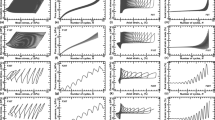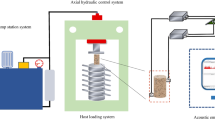Abstract
Shear strength of a sandstone–mudstone particle mixture, filled along the bank of a large reservoir and subjected to wet–dry cycle induced by the rise–lower cycle of water level, may be affected by the wet–dry cycle. To investigate the effects, two-type triaxial tests, without and with the wet–dry cycle, were carried out. The experimental data indicate that the shear strength, denoted by peak deviator stress (σ1 − σ3)f, angle of shearing resistance φ, nonlinear shear strength indicators φ0 and φd, or linear shear strength indicators φ* and c, is reduced by the wet–dry cycle. With the increment of cycle from 1 to 20, the decrement of shear strength, denoted by the parameters mentioned above, is increasing in a logarithmic relationship. Furthermore, the effect is also related to the confining pressure and stress level selected in the tests. Based on analyzing experimental data, several logarithmic functions, used to predict the shear strength of the mixture after the wet–dry cycle, were suggested. Due to the effect of the wet–dry cycle, stability of a slope, filled in waterfront conditions using the mixture, is reduced.












Similar content being viewed by others
References
Xiao Y, Liu H, Chen Y, Zhang W (2014) Particle size effects in granular soils under true triaxial conditions. Geotechnique 64(8):667–672
Trauner L, Dolinar B, Mišič M (2005) Relationship between the undrained shear strength, water content, and mineralogical properties of fine-grained soils. Int J Geomech 5:350–355
Lim Y, Miller G (2004) Wetting-induced compression of compacted Oklahoma soils. J Geotech Geoenviron Eng 130(10):1014–1023
Park S (2010) Effect of wetting on unconfined compressive strength of cemented sands. J Geotech Geoenviron Eng 136(12):1713–1720
Thorel L, Ferber V, Caicedo B, Khokhar IM (2011) Physical modelling of wetting-induced collapse in embankment base. Géotechnique 61(5):409–420
Lane PA, Griffiths DV (2000) Assessment of stability of slopes under drawdown conditions. J Geotech Geoenviron Eng 126(5):443–450
Berilgen MM (2007) Investigation of stability of slopes under drawdown conditions. Comput Geotech 34(2):81–91
Jia GW, Zhan TLT, Chen YM, Fredlund DG (2009) Performance of a large-scale slope model subjected to rising and lowering water levels. Eng Geol 106:92–103
Fattah MY, Omran HA, Hassan MA (2015) Behavior of an earth dam during rapid drawdown of water in reservoir—case study. Int J Adv Res 3(10):110–122
Fattah MY, Omran HA, Hassan MA (2017) Flow and stability of Al-Wand earth dam during rapid drawdown of water in reservoir. Acta Montanistica Slovaca 22(1):43–57
Rajaram G, Erbach DC (1999) Effect of wetting and drying on soil physical properties. J Terrramech 36(1):39–49
Guan GS, Rahardjo H, Choon LE (2010) Shear strength equations for unsaturated soil under drying and wetting. J Geotech Geoenviron Eng 136(4):594–606
Ng CWW, Leung AK (2012) Measurements of drying and wetting permeability functions using a new stress-controllable soil column. J Geotech Geoenviron Eng 138(1):58–68
Goh SG, Rahardjo H, Leong EC (2014) Shear strength of unsaturated soils under multiple drying-wetting cycles. J Geotech Geoenviron Eng 140(2):06013001
Gallage C, Uchimura T (2016) Direct shear testing on unsaturated silty soils to investigate the effects of drying and wetting on shear strength parameters at low suction. J Geotech Geoenviron Eng 142(3):04015081
Fattah MY, Al-Ani MM, Al-Lamy MTA (2015) Wetting and drying collapse behaviour of collapsible gypseous soils treated by grouting. Arab J Geosci 8(4):2035–2049
ASTM (American Society for Testing Materials) Standard D7181-11 (2011) Standard test method for consolidated drained triaxial compression test for soils. Annual book of ASTM standards, West Conshohocken
Wang JJ, Qiu ZF, Bai J, Yu C, Liu MW (2018) Deformation of a sandstone–mudstone particle mixture induced by periodic saturation. Mar Georesour Geotechnol 36(4):494–503
CN (Chinese National) Standard GB/T 50123-1999 (1999) Standard for soil test method. The Ministry of Housing and Urban–Rural Development of P. R. China, Beijing (in Chinese)
ASTM (American Society for Testing Materials) Standard D2487 (2000) Standard practice for classification of soils for engineering purposes (Unified Soil Classification System). Annual book of ASTM standards, West Conshohocken
Huang S, Wang J, Qiu Z, Kang K (2018) Effects of cyclic wetting-drying conditions on elastic modulus and compressive strength of sandstone and mudstone. Processes 6:234
Duncan JM, Chang CY (1970) Nonlinear analysis of stress and strain in soils. J Geotech Eng Div ASCE 96(SM5):1629–1653
Barton N, Kjaernsli B (1981) Shear strength of rockfill. J Geotech Eng Div ASCE 107(7):873–891
Viratjandr C, Michalowski RL (2006) Limit analysis of submerged slopes subjected to water drawdown. Can Geotech J 43(8):802–814
Gao YF, Zhang F, Lei GH, Li DY (2013) An extended limit analysis of three-dimensional slope stability. Géotechnique 63(6):518–524
Gao YF, Zhu DS, Zhang F, Lei GH, Qin HY (2014) Stability analysis of three-dimensional slopes under water drawdown conditions. Can Geotech J 51(11):1355–1364
Luo F, Zhang G (2016) Progressive failure behavior of cohesive soil slopes under water drawdown conditions. Environ Earth Sci 75(11):1–12
Bishop AW (1955) The use of the slip circle in the stability analysis of slopes. Géotechnique 5(1):7–17
Acknowledgements
The authors gratefully acknowledge financial supports from the National Key R&D Program of China under no. 2018YFC1504903, the National Natural Science Foundation of China under Grant nos. 51479012 and U1865103, and the Chongqing Science and Technology Commission of China under Grant no. cstc2017kjrc-cxcytd30001, respectively.
Author information
Authors and Affiliations
Corresponding author
Rights and permissions
About this article
Cite this article
Tang, SC., Wang, JJ., Qiu, ZF. et al. Effects of Wet–Dry Cycle on the Shear Strength of a Sandstone–Mudstone Particle Mixture. Int J Civ Eng 17, 921–933 (2019). https://doi.org/10.1007/s40999-019-00393-7
Received:
Revised:
Accepted:
Published:
Issue Date:
DOI: https://doi.org/10.1007/s40999-019-00393-7




